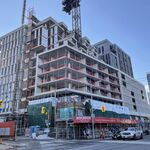Is anyone in TTC doing that with the DRL? I thought it was merely an exercise in reproducing the 1986 work for an internal apples-to-apples comparison. Both TTC and Metrolinx have already modelled other DRL options recently.
To me the most valuable comparison would be between the optimal alignments for 2 different categories: highest ridership, and lowest engineering complexity (and by correlation cost). If they happen to be one and the same, or they are very close to each other, then you have your answer.
My hunch would be that the lowest cost option would be running the Pape-rail corridor alignment as was proposed in Network 2011. I think the reasons behind that are fairly obvious.
However, my hunch for the highest potential ridership would be a Wellington-Front-Parliament alignment. My rationale behind that is that no matter what alignment is chosen (aside from one that's from way out in left field), you're going to get the bypassing Bloor-Yonge crowd on board, and you're going to get the streetcar transfers on board. Those numbers aren't going to change very much, as many of those people will be transferring simply because the line exists. The streetcar transfers may be a bit more fussy because the location E-W wise may be a bit more of a factor. But for most B-D passengers, as long as the transfer point is east of Yonge, it serves them quite well.
That means that the only real variable to increase ridership is walk-ins, and walk-ins come from density. Not only does the Parliament corridor have the highest density out of any of the N-S links to B-D, it's really the only one that has significant opportunity to get even denser.
The area east of the Don may see some nodal densification around subway stations, but it will pale in comparison to what is going to be happening along Parliament in the next 20 years as the wall of condos pushes further east from Yonge St. In terms of walk-ins, both now and in the future, the Parliament corridor wins hands down.
Everyone is asking where the DRL should come into downtown, what E-W alignment in should take. Not enough people are talking about what the best N-S alignment is to connect to B-D. To me that question is just as important.




